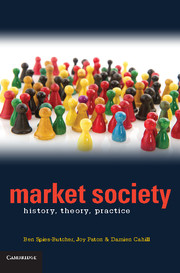Book contents
- Frontmatter
- Contents
- Acknowledgements
- 1 Introducing market society
- Part 1 Constituting market society
- Part 2 Regulating market society
- Part 3 Living market society
- 8 Work, consumption and quality of life
- 9 Family, environment and sustainability
- 10 Civil society, community and participation
- Concluding remarks
- References
- Index
Concluding remarks
from Part 3 - Living market society
Published online by Cambridge University Press: 05 June 2012
- Frontmatter
- Contents
- Acknowledgements
- 1 Introducing market society
- Part 1 Constituting market society
- Part 2 Regulating market society
- Part 3 Living market society
- 8 Work, consumption and quality of life
- 9 Family, environment and sustainability
- 10 Civil society, community and participation
- Concluding remarks
- References
- Index
Summary
IN THIS BOOK we set out to understand market society by linking a range of conceptual lenses to the historical experience of capitalism in practice. We have sought to demonstrate how the economy is both embedded in social life while also shaping social life. In the first part of the book we examined key elements constituting the capitalist economic system and the way these have been understood. We discussed how commodity-based production expands, generating wealth but also periodic crises. These, in turn, exacerbate the inherent inequalities and conflict upon which market societies have historically been based. In all these respects, the constitutive economic processes – production and commodification, accumulation and crisis, distribution and conflict – are embedded in a range of institutional forms. These serve to integrate the ‘anarchy’ of private commodity production with the process of social provisioning.
In the second part of the book, we examined how these core institutions regulate market society giving ‘unity and stability, structure and function’ to actual existing economies (Polanyi 1957, p. 249). We examined how the state and market developed alongside each other with the state creating and regulating markets and the private corporation. We argued that the market itself is an important regulatory institution. Its competitive forces provide strong incentives for people to act in certain ways, which is reinforced by the dependence of most people on market income to survive. However, these competitive forces have themselves been shaped by the rise of large corporations which have also become powerful political actors. These three regulatory institutions also profoundly shape our experience of the economy and everyday life.
- Type
- Chapter
- Information
- Market SocietyHistory, Theory, Practice, pp. 238 - 239Publisher: Cambridge University PressPrint publication year: 2012



